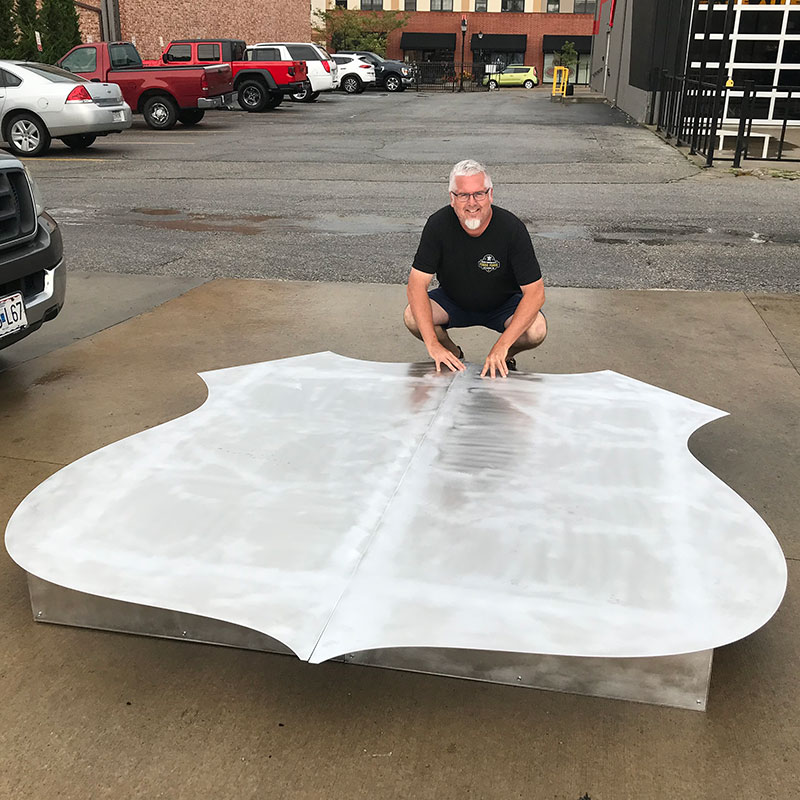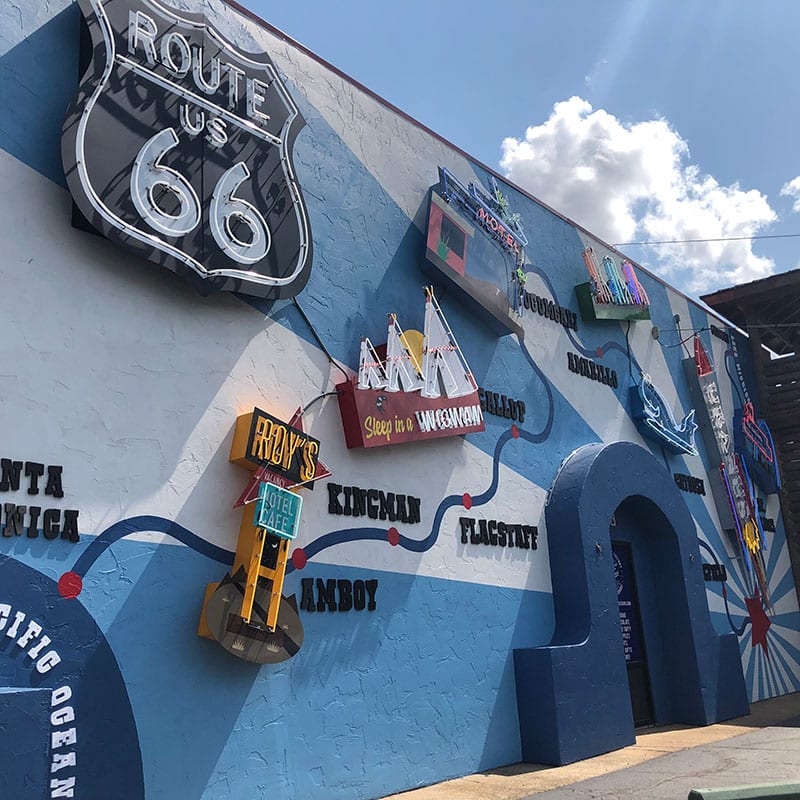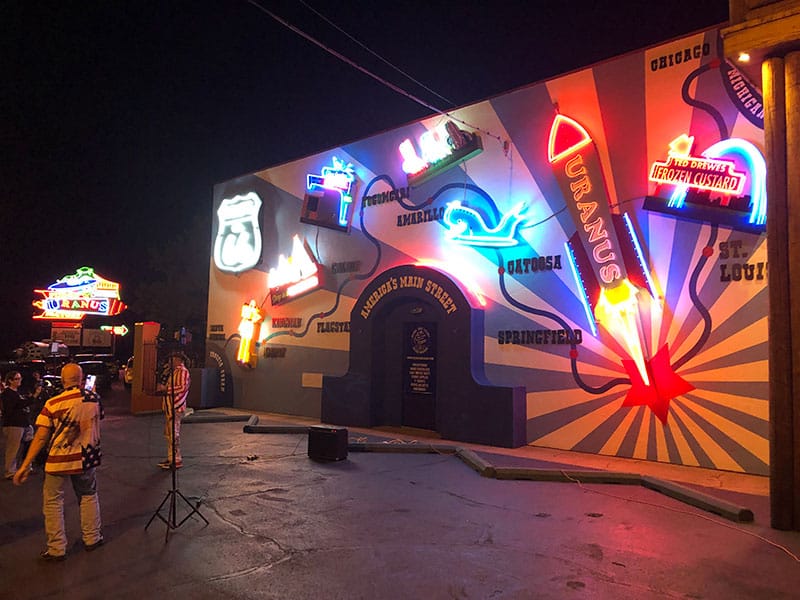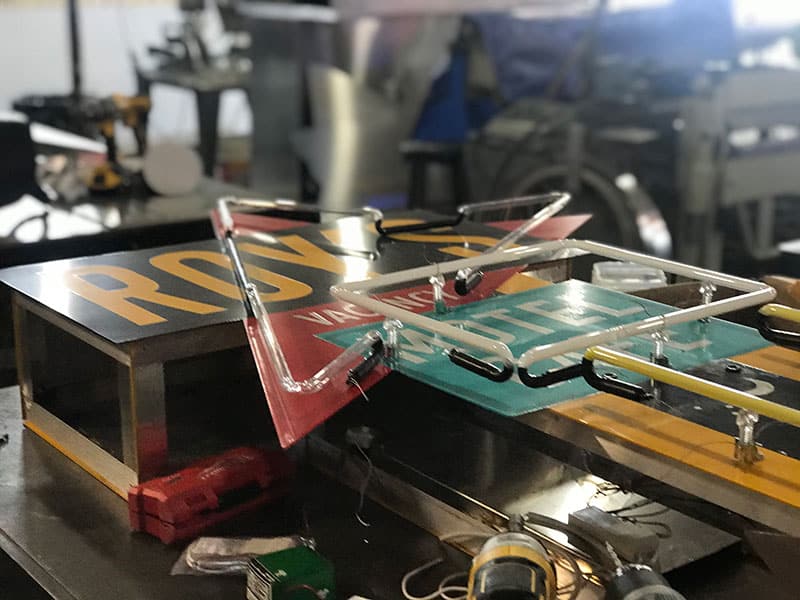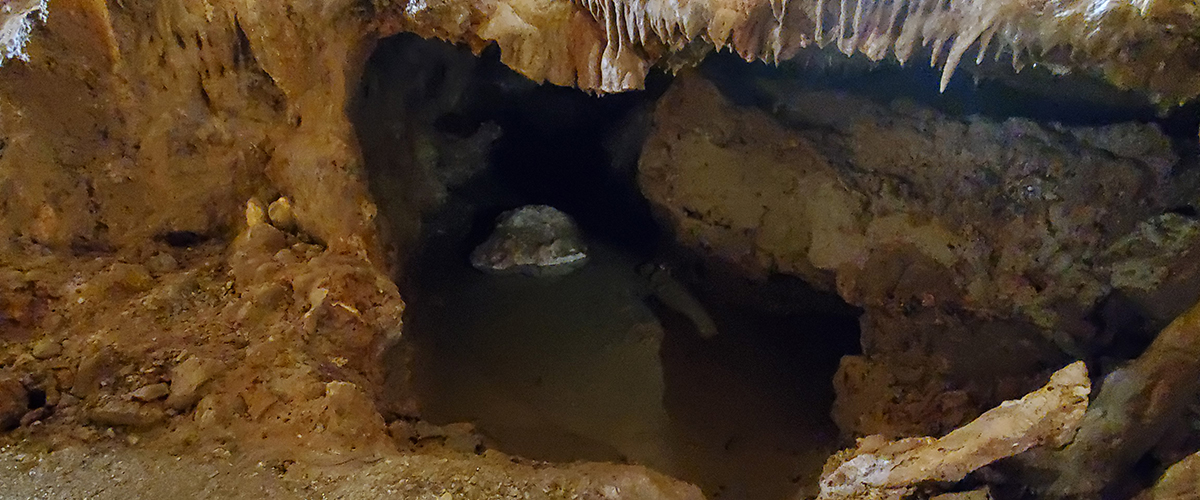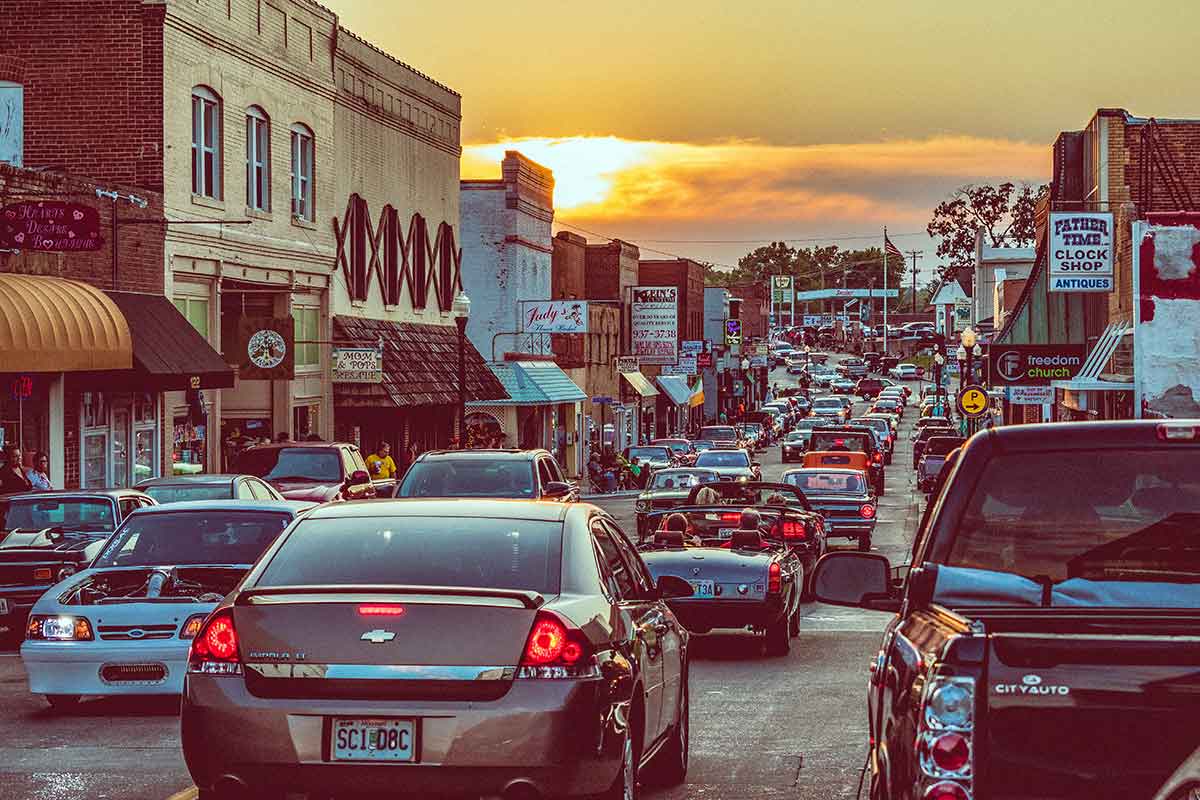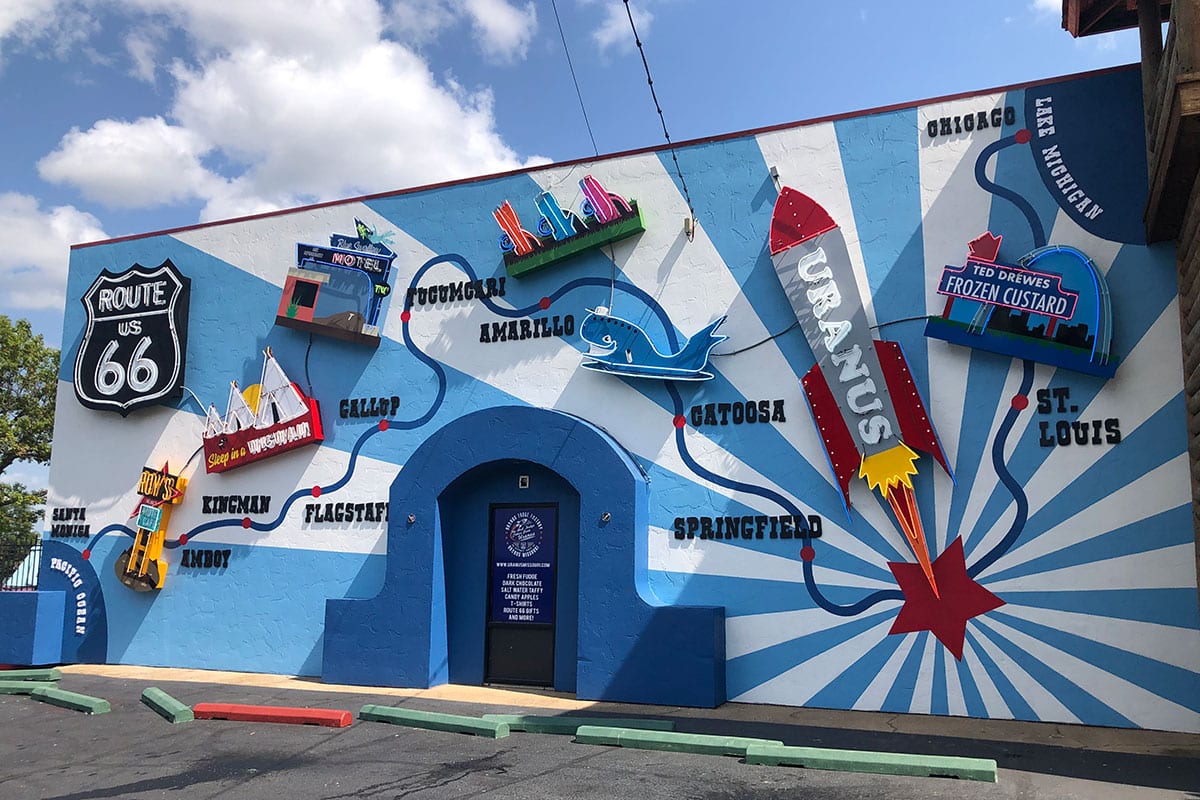
The massive mural at Uranus celebrates Route 66’s most iconic sites. This work was produced by Fossil Forge’s David Eames, Ben Wine, and Remy Norton-Hood. The trio also partnered with Greg Garnett of Gama Neon to create the glasswork. Garnett brought 40-plus years of expertise to the project, from color choices to animation.
Lee’s Summit team sheds (neon) light on historic sign making
This article first appeared in the June 2022 issue of Missouri Life magazine.
Rustic diners. An iconic downtown theater. A historic stretch of Route 66.
Fossil Forge owners Dave Eames and Ben Wine specialize in respecting the past with a classic American craft. The duo has been restoring and building signage, including custom neon, from their shop in downtown Lee’s Summit since 2015. Their colorful, attention-grabbing signage hangs across Missouri and the greater Midwest, infusing storefronts, restaurants, and roadside attractions with an eye-catching sense of nostalgia.
And yes, it’s work. But it’s also art.
This is most apparent at their recent installation on the Mother Road at Uranus, in St. Robert.
This kitschy roadside attraction was already famous for its cheeky fudge marketing and America’s largest belt buckle, but Mayor Louie Keen wanted something even bigger. He turned to Facebook and published a call for sign makers.
Dave and Ben sketched a map of Route 66 overlaid with eight neon pieces to honor the highway’s most iconic stops. Their concept was so clear that Mayor Keen bit immediately.
After finalizing the plan over the following week, Dave and Ben got to work.
Eight round trips to Uranus
They tackled the project piece-by-piece. In early summer, they painted the map, which included blue and white striping that radiated from its focal point landmark: Uranus.
Once they finished building the neon components, transport could begin. But the pieces were massive, and their lumbering bucket truck couldn’t handle more than one piece per delivery. Plus, driving eight round-trip interstate hauls just wasn’t their style. Instead, they opted for the scenic backroads that wind around Lake of the Ozarks, keeping their eyes peeled for any inspirational retro signage to note along the way.
“We never took the same path there and back,” Ben says. “It was fun seeing all the ways to get around the lake in that area.”
Today, the 50-by-25-foot mural is visible from both Route 66 and nearby I-44, too. It’s their biggest project to date, and perhaps the one with the most personal significance.
“It’s very gratifying to see people posting pictures of the neon mural now because it means something to somebody else,” Dave says. “It’s a true sense of place. It’s a true sense of history. Having these interesting places that don’t look like every interchange in America—that geography of nowhere— that’s the difference, that’s what we’re interested in: these unique stretches of road and making them places where people want to go.”
Retro charm is glowing again
Back in Lee’s Summit, Fossil Forge’s neon work amplifies the retro charm of downtown. Bright yellow letters greet patrons from Stuey McBrew’s street-facing windows. At the historic Vogue Theater, the newly restored 15-foot-tall sign glows once again. While their downtown shop has the air of a generational business, the company actually began in Dave’s garage in 2003.
At the time, Dave was an illustrator for The Kansas City Star. In his spare time, he taught himself to weld outdoor products like garden art and gates. A decade later, he did an install at Main Slice, a downtown Lee’s Summit pizza parlor. Ben was part-owner at the time, and when he saw the work Dave was doing, he felt a pang of awe—and envy.
“I was jealous,” Ben says. After quitting the restaurant industry, Ben worked for a few sign companies before joining Fossil Forge. Today, he is the lead fabricator and designer while Dave oversees business logistics and client relations.
“It’s very gratifying to see people posting pictures of the neon mural now because it means something to somebody else.”
They run a crew of three in their 2,200-square-foot workshop, a historic 1920s structure that once housed a Buick car dealership and manufacturing facility. As Dave puts it, the setting has “a really cool history of making and fixing things.”
On the floor, they mix vintage tools and high-tech equipment: a state-of-the-art CNC (computer numerical control) plasma-cutting machine and router sit near a traditional forge and anvil. The antique equipment and older tools fit the vibe of the shop and the duo’s business mission, too.
“Using old tools and techniques is really part of our shop. When you come up to an old tool, the shape, the smell, the sounds—it makes you feel inspired to work. There are similar newer tools that are maybe more efficient, but we’re not a high-enough production shop that those things are important to us. We like the way the old things look,” Dave says.
These weren’t Microsoft fonts
While neon signage is a technique with deep American roots, Dave and Ben don’t frame what they do through a mission to preserve nostalgia, but rather that history is a muse.
“Dave and I have always loved old highways, old Americana. Just the signage, the graphics, logos, everything was just done right. We try and reflect that in our new signage,” Ben says. “Back then, everything was designed by hand. Typefaces were hand-drawn, not a font out of a package on Microsoft. It was artists doing their own scripts and layouts; they didn’t have computers. Everything was drawn and hand-cut and has that character. If you came into our shop, you’d see dozens of cool old signs hanging from the walls and ceiling, and also brand-new stuff. It’s an influence we’re really proud of.”
That design aesthetic is exactly what’s made them so popular.
When Stuey McBrews owner Justin Bliefnick started thinking about getting a new a sign for his business in 2019, he didn’t know exactly what he wanted. But with Fossil Forge right next door, he knew Ben and Dave were the right team to help him figure it out.
“Ben and I sat at the bar drawing on napkins for what the flashing pint glass could look like, sorting through fonts to find letters that would look good in these tall windows,” he says. “I prefer working with the guys next door—and I like the vintage art that they produce. There’s something very appealing about it. In a bar, you have all the beer neons so that’s not new, but having something specifically crafted for us and our concept makes us stand out.”
It’s this sense of individuality that gives downtown Lee’s Summit such a distinct sense of place. Fossil Forge is directly responsible for helping their city achieve that. What they do is more than business and art—it’s the kind of community revitalization that’s essential for sustaining historical commercial districts.
A unique design aesthetic
It wasn’t always that way. For years, neon was illegal in their community. The form gained a bad reputation during the ’60s and ’70s due to its association with so-called seedy establishments. Around that time, many city councils across America, including the council in Lee’s Summit, began banning the use of neon in signs. And then Dave and Ben got involved. It just didn’t seem right that they couldn’t display their creative work in their own neighborhood, so they approached the city and got the ordinance lifted.
“As a community, we thought this was a really beautiful art form, in a commercial sense,” Ben says. “Now we have 18 to 20 neon signs in downtown Lee’s Summit, and I would put us up against any place in the state as a vibrant business district.”
Mayor Bill Baird agrees. “The reintroduction of neon signs into our downtown gave the city two opportunities: It connected the city with its past, and it established a unique design aesthetic not available anywhere else in the city. Fossil Forge is well-suited to produce these sorts of signs as their shop is located within our downtown and they produce customized handcrafted signage that harkens back to the quality of historic signs.”
Vibrant, historical downtowns aren’t just about eliminating empty storefronts and the preservation of old buildings. It’s also about beauty and branding. And when it comes to neon, they’re a classic American signature of independent business, rather than franchises that homogenize the national landscape.
Classic doesn’t have to mean it remains in the past—if anything, Fossil Forge’s work proves that the aesthetic of the days gone by has a place in the present, too.
“There’s a nostalgic feeling to neon that helps to connect downtown to its past. Neon requires a high level of artistic and handcrafted skill that you don’t see in modern signage. As small business owners themselves, Dave and Ben understand how important signage is for a business and, paired with their love of history, they are able to create signage that has a strong visual and artistic connection to a place,” says Donnie Rodgers, executive director of Downtown Lee’s Summit Main Street.
Emphasizing the meaning of a sense of place is crucial to Dave and Ben’s business philosophy. They approach daily work with the expertise of craftsmen at the top of their game—but this isn’t a purely artistic pursuit. Signs serve a commercial purpose, and Fossil Forge’s priority is to be as successful as possible in achieving that for their customers and the broader communities that they serve.
“I don’t think of what we do as just nostalgic or remembering the good old days. We take the visual communication of that era because it was effective, and we try to be influenced by that,” Ben says. “You can make a really cool statement with an iconic sign. It’s a good message that says, ‘This is important. This place matters.’”
Photos—Fossil Forge
Related Posts
Missouri’s Show Caves
With more than 6,400 recorded caves, including twenty show caves that are open to the public for guided tours, travelers and spelunkers around the world know Missouri as The Cave State.
Revitalizing Missouri Downtowns
Here’s how Missourians are working together to revitalize downtowns across the state.

